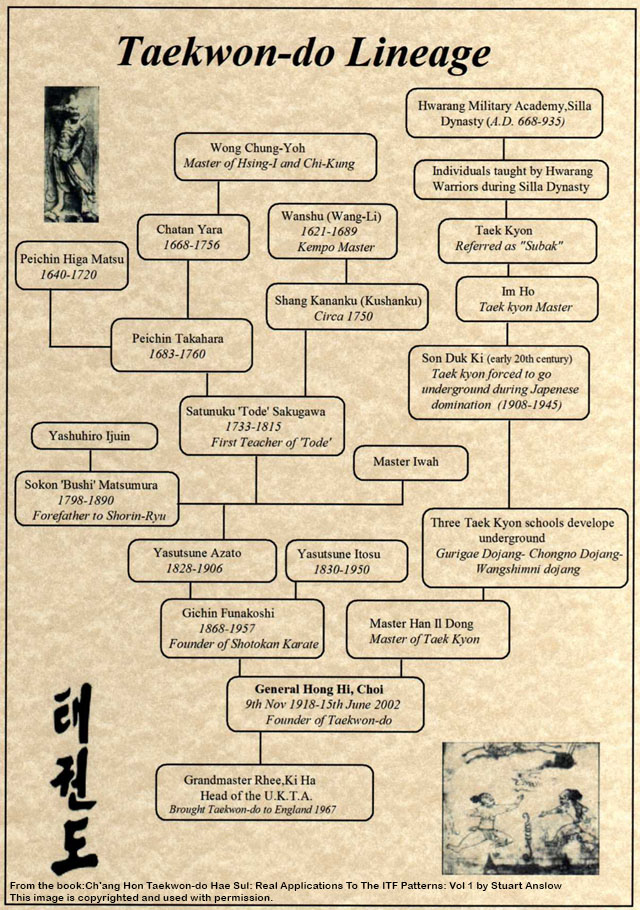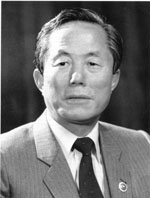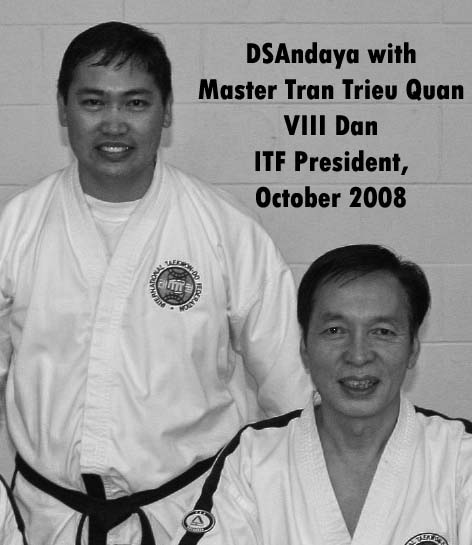| |
What is Taekwon-do?
Taekwon-do is famous for its spectacular range of kicks and punches. The study of Taekwon-Do aims not only to develop the student physically, but mentally also, creating a well rounded and balanced individual. To achieve this aim General Choi Hong-Hi based his art on Asian moral culture and included in his art the Tenets of Taekwon-Do;
-
Courtesy
-
Integrity
-
Perseverance
-
Self-Control
-
Indomitable Spirit
By incorporating these basic values into one's behaviour, General Choi believed a person could become a better member of society.Through regular practice of Taekwon-Do a student can expect to achieve noticeable physical benefits including; Strength, Speed, Co-ordination, Balance, Endurance, Flexibility, Weight regulation and Self Confidence.
A Taekwon-Do class provides a dynamic cardiovascular workout combined with strength work, conditioning and stretching to increase flexibility.
Back to top History of Taekwondo
 Tae Kwon Do is a martial art developed over 20 centuries ago in Korea. The earliest records of its practice date back to 50BC where tomb paintings show men in fighting stances practising forms known as Taek Kyon. Tae Kwon Do is a martial art developed over 20 centuries ago in Korea. The earliest records of its practice date back to 50BC where tomb paintings show men in fighting stances practising forms known as Taek Kyon.
It is believed that the origins of Taek Kyon date even further back and originated as self-defence against wild animals whose defensive and offensive movements were also the subject of much analysis. Taek Kyon, at the time was only one style of fighting. Others had names such as Subak, Tak Kyon and so on.
By 57 BC Korea had three kingdoms (Koguryo, Paekje and Silla) and, with a certain degree of inevitability, a strong rivalry amongst them led to the focus on the development of very effective fighting techniques.
History, repeatedly, has shown that it is the victor who writes the script and this case was no exception. Silla won its wars against its two rivals and in 668 AD it unified the three kingdoms. Instrumental in its victory were the Hwa Rang Do, an elite group of young men who were devoted to cultivating their bodies and minds and serving the kingdom.
Hwa Rang Do, quite literally, means flowering youth (Hwa=flower, Rang=young man) and the young noblemen of the Hwa Rang Do practised various forms of martial arts. The Hwa Rang Do also developed an honour code and it is this which today forms the philosophical background of Tae Kwon Do.
In 936AD the Silla dynasty came to an end and with it the kingdom. In its place, Wang Kon founded the Koryo dynasty. Koryo is an abbreviation of Koguryo which Wang Kon sought to revive. The modern name Korea is derived directly from the word Koryo.
It was during the Koryo that a new sport was given form. It was called Soo Bakh Do and it was used, principally, as a military training method. Drawing from the many different forms of martial arts which had preceded it Soo Bakh Do used bare hands and feet as a weapon and its intensity was such that it was seen as a very good way of maintaining one's strength and overall fitness. As a result its popularity spread throughout the kingdom of Koryo.
This was the precursor to modern day Tae Kwon Do. Despite its effectiveness as a means of training for warfare however and its popularity with the peasants in the fields by 1492 it had almost disappeared.
What happened was that King Taejo, founder of the Yi dynasty, replaced Buddhism with Confucianism as the state religion. The teachings of Confucius, imported from the refined, rarefied culture of China, dictated that the higher class of man should read poetry and music and the practice of martial arts should be something left to the less refined, even inferior, man.
The Yi dynasty lasted from 1392 to 1910 and during that time the practice of martial arts and the code of honour of the Hwa Rang remained alive in isolated, stubbornly traditional cultural backwaters of Korea.
In 1910 however Korea was invaded by Japan who dominated it until the end of World War II. The Japanese tried to erase all of the Korean culture including its martial arts. As is usual with such situations this brought a stubborn resurgence in the practice of martial arts which now, once more, had a very practical role to play against an invader who strictly controlled the supply of weapons.
Along with occupation, the Japanese also brought karate with them and indeed the quick, straight-line movements which characterise many Tae Kwon Do moves today are a direct result of the legacy left behind by the Japanese army of occupation.
After the end of World War II, when Korea became independent, several Kwans, or fighting styles, arose. These were: Chung Do Kwan, Moo Duk Kwan, Yun Moo Kwan, Chang Moo Kwan, Oh Do Kwan, Ji Do Kwan, Chi Do Kwan and Song Moo Kwan. All these Kwans were united in 1955 under the name of Tae Soo Do.
Korea's struggle to re-discover its identity and many traditions was, with some degree of inevitability, reflected in the subsequent development of its martial arts movement and by the beginning of 1957 several Korean martial arts masters had adopted the name Tae Kwon Do for their form of martial arts, because of its similarity to Tae Kyon.
The very first Tae Kwon Do students were soldiers because General Choi Hong-Hi, who is credited as the father of modern Tae Kwon Do, required his soldiers to train in it. The name Taekwon-Do was and unveiled to the world by General Choi Hong-Hi on the 11th April 1955.
The police and air force had to train in Tae Kwon Do as well. At the time Tae Kwon Do was still very heavily under the influence of Japanese karate and, indeed, many of its moves and style bore a very close resemblance to Shotokan Karate. In 1961, however, the Korean Tae Kwon Do Union arose from the Soo Bakh Do Association and the Tae Soo Do Association. In 1962 the Korean Amateur Sports Association acknowledged the Korean Tae Kwon Do Union and in 1965 the name was set to Korean Tae Kwon Do Association (KTA).
General Choi Hong-Hi was president of the KTA at the time and he was asked to start the International Tae Kwon Do Federation (ITF) as the international branch of the KTA. What follows next is best described as the rise of the acronyms. In 1961, following the overthrow of the southern government of Korea general Choi left for the United States where he established the ITF as a separate entity, in 1963. Back to top
The ITF (International Taekwon-do Federation
 The DSA Royal International Taekwon-Do Club is affiliated with the Canadian Taekwondo Federation Internationale under the direction of the International Taekwon-Do Federation (ITF). The DSA Royal International Taekwon-Do Club is affiliated with the Canadian Taekwondo Federation Internationale under the direction of the International Taekwon-Do Federation (ITF).
ITF was founded on 22nd March 1966 by General Choi Hong Hi, the Founder of Taekwon-Do, to promote the teaching of this martial art around the world. At that time, nine countries were involved: Korea, Vietnam, Malaysia, Singapore, West Germany, USA, Turkey, Italy, and Egypt. Taekwon-Do is now taught in almost every country around the world, and General Choi is recognised as the Father of Taekwon-Do.
The ITF's present headquarters is in Vienna, Austria.
Mission: The mission of the ITF is to represent, promote, and work for the development of the practice of Taekwon-Do in all countries by:
-
Coordinating and certifying Taekwon-Do activities such as competitions and seminars
-
Setting and enforcing high quality standards for technical and teaching
-
identifying and collaborating with affiliated organizations, such as Continental Federations, National Associations, and Allied National Associations
-
Providing assistance to local Taekwon-Do organizations
-
Certification for Black Belt holders, international instructors and umpires.
Fundamental Values
 Practitioners of Taekwon-Do recognise that they are forever students of our Founder, General Choi Hong Hi. The ITF and its affiliated organisations will strengthen and promote the legacy of General Choi as described in his Encyclopaedia of Taekwon-Do, notably the twenty-four patterns and the philosophy. Practitioners of Taekwon-Do recognise that they are forever students of our Founder, General Choi Hong Hi. The ITF and its affiliated organisations will strengthen and promote the legacy of General Choi as described in his Encyclopaedia of Taekwon-Do, notably the twenty-four patterns and the philosophy.
The ITF belongs to all its members; it must work for its members and with its members to provide the services they need and require.
The ITF and its affiliated organisations are always open to suggestions from members and encourage innovative ideas.
The ITF and its affiliated organisations are and must remain free of all political influence.
All qualifications and promotions within the ITF and its affiliated organisations will be attributed according to merit and in conformity with well-established criteria.
The respect of hierarchy authority is an important principle in all martial arts. All members of ITF will respect those who are their seniors in the organisation, particularly their teacher. On the other hand, the seniors will treat their students and other juniors with respect and fairness.
Back to top |
|